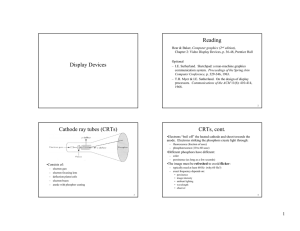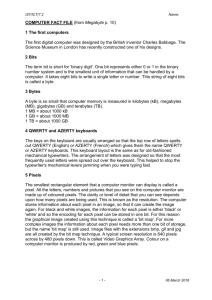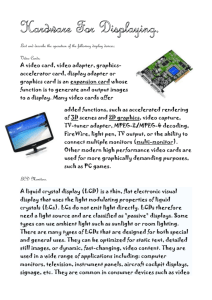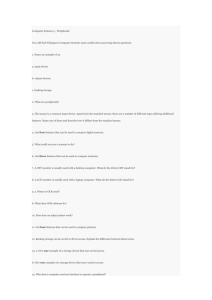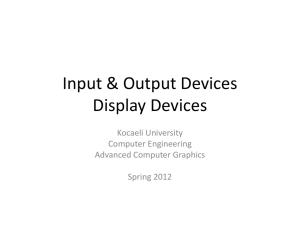COMP136: Introduction to Computer Graphics
advertisement
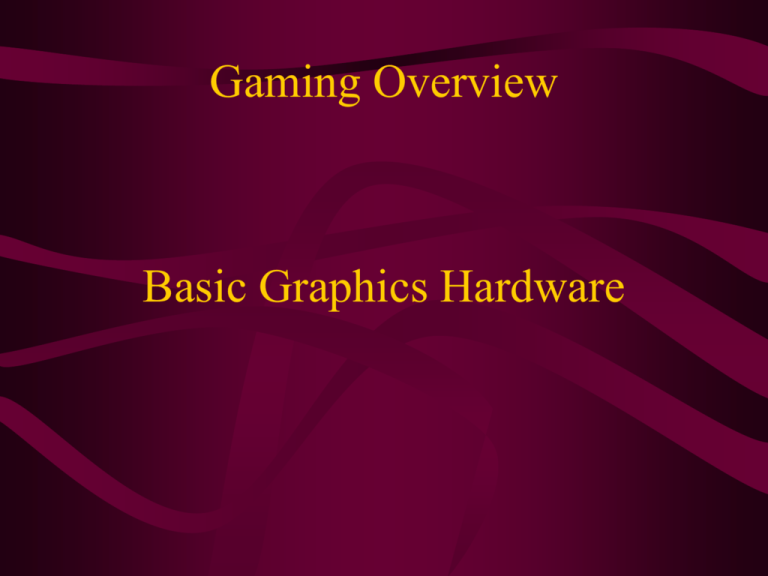
Gaming Overview Basic Graphics Hardware Outline • Image Basics • Graphics Hardware – Input • Describing something to the computer – Computation • Computing what we want to draw – Output • Final representation Two Dimensional Images • Images (at least the ones in this class) are two dimensional shapes. • The two axes we will label as X (horizontal), and Y (vertical). +Y Y Axis (0,0) X Axis +X Hardware Pipeline Input Computation Output We want to draw a rectangle, how do we describe it to a computer? Model (n) - object description that a computer understands. Partition the space 1. Define a set of points (vertices) in 2D space. (7,9) (14,9) 2. Given a set of vertices, draw lines between consecutive vertices. (7,3) (14,3) Vertex (pl. Vertices) - a point in 2 or 3 dimensional space. Record every position Bitmap - a rectangular array of bits mapped one-to-one with pixels. Position relative Vector display system - graphical output system that was based on strokes (as opposed to pixels). Also known as: random, calligraphic, or stroke displays. Representing Objects • Most common method is the VERTEX method. Define the object as a set of points with connectivity information. • Why is connectivity important? Connectivity - information that defines which vertices are connected to which other vertices via edges. Edge - connects two vertices How do we do this? Input Devices • Locator Devices • Keyboard • Scanner – Images – Laser • Cameras (research) Locator Devices When queried, locator devices return a position and/or orientation. •Paint Programs •Mouse (2D and 3D) •Trackball •Modelling Programs (ex. Maya, •Joystick (2D and 3D) 3DStudio) •Tablet •CAD/CAM •Virtual Reality Trackers •Magnetic, Acoustic, Inertial, •General System Interface Optical Keyboard • Text input – List boxes, GUI – CAD/CAM – Modelling • Hard coded – Vertex locations are inserted into code Scanners • Image Scanners - Flatbed, etc. – What type of data is returned? Bitmap • Laser Scanners - Deltasphere – Emits a laser and does time of flight. Returns 3D point • Camera based - research – Examine camera image(s) and try to figure out vertices from them. Computation Stage Input Computation Output • Now that we have a model of what we want to draw, what goes on inside the computer to generate the output? Computation Transformations Rasterization Computation Stage Computation Output Model Rasterization Transformations Transformed Model How do we store this? We would like to allocate memory to hold the results of the computation stage. Framebuffer Framebuffer - A block of memory, dedicated to graphics output, that holds the contents of what will be displayed. Pixel - one element of the framebuffer Framebuffer 0 0 0 0 0 0 0 0 0 0 0 0 0 0 0 0 0 0 0 0 0 0 0 0 0 0 0 0 1 1 1 1 1 1 1 1 0 0 0 0 0 0 0 0 0 0 0 0 0 1 0 0 0 0 0 0 1 0 0 0 0 0 0 0 0 0 0 0 0 0 1 0 0 0 0 0 0 1 0 0 0 0 0 0 0 0 0 0 0 0 0 1 0 0 0 0 0 0 1 0 0 0 0 0 0 0 0 0 0 0 0 0 1 1 1 1 1 1 1 1 0 0 0 0 0 0 0 0 0 0 0 0 0 0 0 0 0 0 0 0 0 0 0 0 0 0 0 0 0 0 0 0 0 0 0 0 0 0 0 0 0 0 0 0 0 0 0 0 Questions: How is much memory do we need todisplay? allocate What How the How largest big many is the image pixels framebuffer? you are can there? for the framebuffer? Framebuffer in Memory • If we want a framebuffer of 640 pixels by 480 pixles, we should allocate: framebuffer = 640*480 bits • How many bit should we allocate? Q: What do more bits get you? A: More values to be stored at each pixel. Why would you want to store something other than a 1 or 0? Framebuffer bit depth • How many colors does 1 bit get you? • How many colors do 8 bits get you? – Monochrome systems use this (green/gray scale) • What bit depth would you want for your framebuffer? bit depth - number of bits allocated per pixel in a buffer Framebuffer bit depths • Remember, we are asking how much memory do we allocate to store the color at each pixel? • Common answers: – 16 and 32 bits Bit depths • 16 bits per pixel (high color) – 5 bits for red, 5/6 bits for green, 5 bits for blue – potential of 32 reds, 32/64 green, 32 blues – total colors: 65536 • 32 bits per pixel (true color) – 8 bits for red, green, blue, and alpha – potential for 256 reds, greens, and blues – total colors: 16777216 (more than the eye can distinguish) • Let’s look at Display Control Panel Data Type Refresher • • • • • • • bit - a 0 or 1. Can represent 2 unique values byte - 8 bits. 256 values word - 32 bits. 4,294,967,296 values int - 32 bits. float - 32 bits double - 64 bits unsigned byte - 8 bits Memory unsigned byte framebuffer[640*480*3]; framebuffer = [255 255 255 0 0 255 0 0 255 0 255 0 255 0 0 0 255 0 0 255 0 …] Graphic Card Memory • How much memory is on our graphic card? – 640 * 480 * 32 bits = 1,228,800 bytes – 1024 * 768 * 32 bits = 3,145,728 bytes – 1600 * 1200 * 32 bits = 7,680,000 bytes • How much memory is on your graphics card? • As a side note: Playstation 1 has 2 MB RAM. How do they do it? What is the TV resolution? 1 bit alpha, no z buffer. A: Egads! Not enough memory! Q: What is dithering? • Trading spatial resolution for intensity and color depth. • Sometimes call digital half-toning • Increases the number of apparent colors than are actually capable of being displayed True 256colors color colors 16 Dithering • Why does it work? Spatial integration. Using the fact that our eyes usually blend areas of high frequency. • Why do you need it? If you don’t have enough bits. Eyes can detect 100 shades of a color. Banding occurs with fewer colors. • Where do you see this? Printers and newspaper! Let’s look at the Alligator. Black and White Dithering Output Input Computation Output We have an image (framebuffer or model), now we want to show it. • Hardcopy • Display – Vector – Raster Scan Vector Displays • Unlike CRTs, vector displays have a single gun that is controlled to draw lines. Think of having a VERY FAST drawing pen. • Pros: Diagrams/only draw what you need • Cons: No fill objects/Slows with complexity Framebuffer -> Monitor The values in the framebuffer are converted from a digital (1s and 0s representation, the bits) to an analog signal that goes out to the monitor. A video card’s RAMDAC performs this operation, once per frame. This is done automatically (not controlled by your code), and the conversion can be done while writing to the framebuffer. Image Quality Issues • Screen resolution • Color • Blank space between the pixels • Intentional image degradation • • • • Brightness Contrast Refresh rate Sensitivity of display to viewing angle Pixels • Pixel - The most basic addressable image element in a screen – CRT - Color triad (RGB phosphor dots) – LCD - Single color element • Screen Resolution - measure of number of pixels on a screen (m by n) – m - Horizontal screen resolution – n - Vertical screen resolution Other meanings of resolution • Pitch - Size of a pixel, distance from center to center of individual pixels. • Cycles per degree - Addressable elements (pixels) divided by twice the FOV measured in degrees. • The human eye can resolve 30 cycles per degree (20/20 Snellen acuity). Color • There are no commercially available small pixel technologies that can individually change color. • Color is encoded by placing differentcolored pixels adjacent to each other. • Field sequential color uses red, blue and green liquid crystal shutters to change color in front of a monochrome screen. Video Formats • • • • • NTSC - 525x480, 30f/s, interlaced PAL - 625x480, 25f/s, interlaced VGA - 640x480, 60f/s, noninterlaced SVGA – 800x600, 60f/s noninterlaced RGB - 3 independent video signals and synchronization signal, vary in resolution and refresh rate • Time-multiplexed color - R,G,B one after another on a single signal, vary in resolution and refresh rate Raster Displays • Cathode Ray Tubes (CRTs), most “tube” monitors you see. Very common, but big and bulky. • Liquid Crystal Displays (LCDs), there are two types transmissive (laptops, those snazzy new flat panel monitors) and reflective (wrist watches). Cathode Ray Tubes (CRTs) Heating element on the yolk. Phosphor coated screen Electrons are boiled off the filament and drawn to the focusing system. The electrons are focused into a beam and “shot” down the cylinder. The deflection plates “aim” the electrons to a specific position on the screen. CRT Phosphor Screen • The screen is coated with phosphor, 3 colors for a color monitor, 1 for monochrome. • For a color monitor, three guns light up red, green, or blue phosphors. • Intensity is controlled by the amount of time at a specific phosphor location. Color CRT •Red, Green and Blue electron guns. G R B G •Screen coated with phosphor triads. •Each triad is composed of a red, blue and green phosphor dot. •Typically 2.3 to 2.5 triads per pixel. B G G R R B B G FLUORESCENCE - Light emitted while the phosphor is being struck by electrons. PHOSPHORESCENCE - Light given off once the electron beam is removed. PERSISTENCE - Is the time from the removal of excitation to the moment when phosphorescence has decayed to 10% of the initial light output. Beam Movement Beam Movement scan line - one row on the screen interlace vs. non-interlace - Each frame is either drawn entirely, or as two consecutively drawn fields that alternate horizontal scan lines. vertical sync (vertical retrace) - the motion of the beam moving from the bottom of the image to the top, after it has drawn a frame. refresh rate - how many frames are drawn per second. Eye can see 24 frames per second. TV is 30 Hz, monitors are at least 60 Hz. • Refresh rate is important, but remember it is different than your program’s update rate. • Why is higher, better? CRTs (cont.) • Strong electrical fields and high voltage • Very good resolution • Heavy, not flat Liquid Crystal Displays (LCDs) • Also divided into pixels, but without an electron gun firing at a screen, LCDs have cells that either allow light to flow through, or block it. Liquid Crystal Displays • Liquid crystal displays use small flat chips which change their transparency properties when a voltage is applied. • LCD elements are arranged in an n x m array call the LCD matrix • Level of voltage controls gray levels. • LCDs elements do not emit light, use backlights behind the LCD matrix LCDs (cont.) • Color is obtained by placing filters in front of each LCD element • Usually black space between pixels to separate the filters. • Because of the physical nature of the LCD matrix, it is difficult to make the individual LCD pixels very small. • Image quality dependent on viewing angle. LCDs (cont.) LCD resolution is often quoted as number of color elements not number of RGB triads. R G B R B R G R G B G B R B R G R G B G B R R G Example: 320 horizontal by 240 vertical elements = 76,800 elements Equivalent to 76,800/3 = 25,500 RGB pixels "Pixel Resolution" is 185 by 139 (320/1.73, 240/1.73) LCDs (cont.) • Passive LCD screens – Cycle through each element of the LCD matrix applying the voltage required for that element. – Once aligned with the electric field the molecules in the LCD will hold their alignment for a short time • Active LCD screens – Each element contains a small transistor that maintains the voltage until the next refresh cycle. – Higher contrast and much faster response than passive LCD Advantages of LCDs • Flat • Lightweight • Low power consumption Projection Displays • Use bright CRT or LCD screens to generate an image which is sent through an optical system to focus on a (usually) large screen. Projector Technology see http://electronics.howstuffworks.com/projection-tv.htm • Two Basic Designs – Transmittive projectors - Shine light through the image-forming element (CRT tube, LCD panel) – Reflective projectors - Bounce light off the image-forming element • In both types of projectors, a lens collects the image from the image-forming element, magnifies the image and focuses it onto a screen Basic Projector Designs (Images from Phillips Research) Reflective Projection System Transmittive Projection System Transmitive Projectors CRT Based CRT-based projectors are usually heavy and large compared to other technologies • One color CRT tube (red, blue, green phosphors) displays an image with one projection lens. • One black-and-white CRT with a rapidly rotating color filter wheel (red, green, blue filters) is placed between the CRT tube and the projection lens. • Three CRT tubes (red, green, blue) with three lenses project the images. The lenses are aligned so that a single color image appears on the screen. Transmitive Projectors • LCD Based – Use a bright light to illuminate an LCD panel, and a lens projects the image formed by the LCD onto a screen. • Small, lightweight compared to CRT based displays Reflective Projectors • In reflective projectors, the image is formed on a small, reflective chip. • When light shines on the chip, the image is reflected off it and through a projection lens to the screen. • Recent innovations in reflective technology have been in the the following areas: – Microelectromechanical systems (MEMS) • Digital micromirror device (DMD, DLP) • Grating light valve (GLV) – Liquid crystal on silicon (LCOS) Digital Light Processing (DLP) (see http://en.wikipedia.org/wiki/Dlp) Single-chip projector Digital Micromirror Device (DMD) • The image is created by a matrix of microscopically small mirrors called a Digital Micromirror Device (DMD) that reflects light either into a projection lens or away from it thousands of times per second • Color is added either by alternately tinting the light source red, green, and blue with a spinning color wheel multiple times per frame (single-chip projector; 16 million colors) or by splitting the light source with a prism that directs the red, green, and blue channels to individual chips which are then recombined (three-chip projector; 35 trillion colors) Advantages/Disadvantages of Projection Display • Very large screens can provide large FoV and can be seen by several people simultaneously. • Image quality can be fuzzy and somewhat dimmer than conventional displays. • Sensitivity to ambient light. • Delicate optical alignment. Displays in Virtual Reality • Head-Mounted Displays (HMDs) – The display and a position tracker are attached to the user’s head • Head-Tracked Displays (HTDs) – Display is stationary, tracker tracks the user’s head relative to the display. – Example: CAVE, Workbench, Stereo monitor
